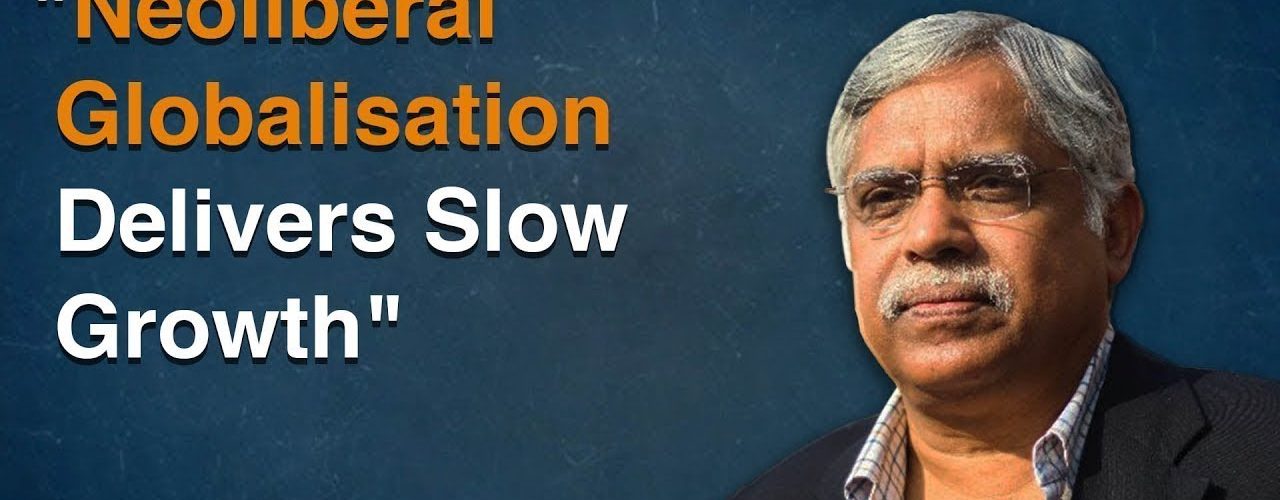The neoliberal trap the Modi government finds itself in is not just an Indian phenomenon, says India’s eminent economist C.P. Chandrasekhar who explains we are staring at a crisis which is enduring and persisting with no evidence that governments which are supposed to manage the economy in situations of crisis are in a position to be able to pull these economies out. That really is the problem all economies face under the neoliberal order.
October 9, 2019 Produced by Lynn Fries / GPEnewsdocs
TRANSCRIPT
C. P. CHANDRASEKHAR: At all point of time you have States and markets operating in tandem. The only thing is, are you in an environment – which of course is politically and socially determined – are you in an environment where it is the State which manages to subordinate and regulate the market? Or are you in an environment where it is the market that subordinates the State, it captures and subordinates the State?
LYNN FRIES: It’s Global Political Economy newsdocs. I’m Lynn Fries. That opening clip was of C.P. Chandrasekhar, a professor of economics at Jawaharlal Nehru University in New Delhi and author of Karl Marx’s Capital and the Present. During a recent visit here in Geneva, Professor Chandrasekhar accepted my invitation to meet up to discuss economic issues relevant not only to his country, India, but to all countries in our globally integrated world economy. This newsdoc features clips of that conversation. We open as Professor Chandrasekhar responds to my questioning him about what exactly he means by a twisted logic at work not only in the economy India but the rest of the world.
Back in March you published a piece call Twisted Logic where you detailed how the Narenda Modi led National Democratic Alliance, a right-wing alliance, was making an aggressive effort to re-write the laws that regulate wages and employment condition of workers, in other words, to dismantle worker protections. You title this article Twisted Logic. Give us the gist of what your message is coming from that.
C. P. CHANDRASEKHAR: The two arguments which are put forth when the case is made for “reforming labor law” as they put it. Of creating a situation where essentially you can have contract labor. You can have hire-and-fire rules which prevail etc. And the first part of the logic which is the first part of the argument put forth is essentially that you need this because of the fact that if you don’t have this you are going to end up with a situation where firms cannot exit because of the fact that they are burdened with this permanent employment. And if they are burdened with this permanent employment, if they have to actually get out of business because of the fact that they have to move on to some other activities because the economy is changing, diversification’s occurring, whatever it may be, new areas of dynamism are visible, they cannot quit the older areas and move unless they pay huge amounts as retrenchment benefit which of course they have to persuade the workers to agree.
So the whole idea is that preventing an exit, you are preventing movement into more dynamic areas and you are reducing investment. Because people would think ten times before investing anywhere because supposing things go sour, you are in some kind of a trap because of the nature of labor law in the country. So the whole idea is unless you have exits, you are not going to have growth. If you don’t have growth, you are not going to have increasing employment. So that in the name of protecting workers, what you are actually doing is preventing growth in employment at a fast enough pace, at the potential pace at which it can grow. The second part of the argument obviously is that this is one thing that is holding back growth in the country in a big way. That having these kind of stringent labor laws supposedly is holding back the country, is holding back growth of business and so on and so forth. And therefore this is something which is inimical to growth in general.
Now as far as the second argument is concerned if I can start with that – the interesting thing is that if you look at workers who could be called formal workers. That is workers who meet the criteria of let us say having any one of the following: having a written wage contract, having the benefit of social security of some kind attached to their job or having the benefit of having paid leave, a certain number of days of paid leave every year as a right. And if you try to look at the percentage of workers who are currently employed who would fall into the category of being one of these, you actually find that formal workers in the Indian economy constitute 7% of the total. So if at all there is any protection, you actually are talking about a segment of the work force which is 7% of the total work force which is getting the benefit of this. Now which basically means of course you can say that something like 40% plus of the work force is in agriculture and agriculture is different but still you are basically saying that only 7% out of something like 50 plus of the total work force actually falls in a category which could be treated as formal workers.
So to treat this as the problem which is holding back the economy or economic growth or business or whatever may be your investment is obviously sort of pushing the argument far too far. The second of course is this whole argument that there is this absence of opportunity to exit and because of this absence of opportunity to exit, you create disincentive to invest and you prevent investment in new areas which would be the areas which would bring you faster growth of both output and employment. Now the difficulty with that argument is that when we look at the history of Indian business, supposing we take one of the sunset industries, you take the textile industry. Over the years India had and has a huge textile industry. And over the years because of segments of that industry not receiving much investment, not going through renovation and modernization and therefore not keeping pace with productivity increases etcetera you ended up with a situation where a number of these units began to suffer losses and they became sick units. Now when these mills became sick, what you actually found is that one of the reasons they became sick was that because industrialists who actually own these mills as and when they had made profits in the past decided to take out those profits and invest them in areas where rates of return are higher. So they were actually taking out capital not meeting minimum requirements in terms of renovation, modernization and expansion of their units in order to remain competitive because of the fact that maybe in electronics, maybe in the chemical industry, maybe in cement, maybe in sugar, who knows where. That you were getting much higher rates of profit and therefore you didn’t want to reinvest to modernize your traditional units and you therefore let them go to seed as it were.
What does that mean? It meant that if Indian capital wanted to exit, it could exit. But who couldn’t exit? Of course, the workers can’t exit because of the fact that the rate of growth of employment is so low that if you exit from an industry, if you lose employment in one industry, you are likely to be unemployed. And you will be forced into taking petty jobs for short periods of time at very low earnings. So therefore the workers do not have the right and ease to exit. And because the workers do not have the right and ease to exit, there is pressure on the government. Because you have these industrialists exiting from the industry, from these units, they are becoming sick. Workers cannot exit. There’s pressure on the government.
So what does the government do? The government began nationalizing these sick units. So the government cannot exit. The workers cannot exit. But actually experience has told us that big capital did exit. So this whole logic that you can actually be in a world in which if you allow exits by allowing hire-and-fire then you are actually going to get huge investment is completely twisted logic according to me.
LYNN FRIES: In a nutshell, sum up on the twisted logic that led to this growth optimism and market euphoria that has now burst, just a brief summary.
C.P. CHANDRASEKHAR: Well, I put it this way. There are two ways in which you can look at crises under capitalism. One is you can look at it as an episodic phenomenon. So just for example you can say 2007-08 was a big crisis, a global financial crisis which was followed by the Great Recession, a huge recessionary crisis. But if you actually look at it with hindsight now, the crisis is not just an episodic phenomenon. You actually are facing a crisis even in a country like India where what you are getting trapped into is a situation of a new normal of decelerating growth or low growth and associated with that a host of other problems. A host of other problems like an extremely volatile currency, the inability to be able to mobilize resources to make investments of the kind which are required even to provide basic fundamentals either for business or the people at large so social infrastructure.
And all of this comes because of the fact that you are caught in a model, in a mode, a strategy in which in the name of incentivizing and facilitating the private sector to make it lead growth, you actually begin to cut back on taxes. In order to be able to please private capital which flows into your country, mobile international capital, you begin to actually rein in the fiscal deficit. If you cannot do that, the State cannot spend.
If the State cannot spend then obviously what used to be one of the important sources of stimulus for growth in capitalist economies begins to lose its potency. People convinced themselves we had no substitute. We had no alternative. For example, that’s true internationally. It was true in India. And that ultimately that essentially consists in the fact that if you ensure that there is a huge amount of liquidity in the system either through the inflow of foreign capital or through monetary policy interventions then that leads to a credit boom. The credit boom then injects demand into the system because it finances consumption. It finances investment. It finances purchases of automobiles. It finances housing investment etcetera, etcetera. And you say, oh look, we are generating growth. But not only is that growth hugely fragile, you are ending up with a situation that when the episodic crisis comes you are trapped in a situation where because of this leverage on the one hand you cannot go back to that way of generating growth. Because lenders don’t want to lend and borrowers are overburdened with debt. And on the other hand, because of the fact that you are tied to this neoliberal commitment to reining in the fiscal deficit within a no tax regime you cannot go back to getting the government to spend.
So you are trapped in what is a creeping crisis which is not episodic in nature which is more generalized across time. And it’s a crisis of that kind which all countries including in India are beginning to face. We didn’t realize this was happening – well not we – the government didn’t realize that this was happening because of the fact that it created this bubble on which the economy was riding because public sector banks were lending huge amounts including into infrastructure as I mentioned and you got growth. But now you cannot get that growth. You cannot go back because of the fact of the legacy foreign capital that has accumulated within your borders. You cannot go back to using the fiscal lever. You cannot tax for the same reason. And therefore you are in this new normal of low growth because of the fact that you are in this neoliberal trap.
And the only solution you seem to be having is to continue to do the same thing. Continue to rely on monetary policy. Continue to rely on injecting liquidity. Continue to rely on changing labor laws. Continue to rely on even more “reforms” in the financial sector and so on and so forth when all of that is what got you into the speculative bubble which finally burst and put you in this situation where you not merely have a crisis episode but you have this creeping long term new normal which is a crisis that fails to resolve itself.
LYNN FRIES: I’d like to put this conversation about the neoliberal bind that the India government finds itself in, in its broader context of the global shift to the right. What’s your take on the analysis that India’s economist, Prabhat Patnaik. Specifically, his view that we are looking at a historical conjuncture where no matter how successful the right may be in the short run in mobilizing the people around a false or divisive agenda. It is basically incapable of leading them out of their current state of unemployment and desperation.
C.P. CHANDRASEKHAR: Yes of course I do agree with him that this is not just an Indian phenomenon this kind of situation where States and governments and the larger sort of capitalist establishment is trapped in this neoliberal bind. The way possibly one can look at it is the following: we keep talking about this whole relationship between States and markets. And the whole idea is to say that the State is in retreat and the market is coming to dominate. I think an alternative way of saying more or less the same thing in the conversation that we are now having is that at all points of time you have States and markets operating in tandem. The only thing is, are you in an environment – which of course is politically and socially determined – are you in an environment where it is the State which manages to subordinate and regulate the market? Or are you in an environment where it is the market that subordinates the State, it captures and subordinates the State. And therefore you happen to be in situation where you need to State to create that environment but that completely denudes the State of capacity to be able to pull systems out of crisis. So I think globally with the rise of finance, the rise of finance capital, which coincided with one, the rise of neoliberalism and of course that coincided with the rise of the right going back to Thatcher and Reagan etcetera.
The rise of finance capital, by allowing for the mobility of capital to create a situation where you actually cannot have a State which is proactive because a proactive State risks the possibility of capital flight of a kind which can even hit an economy like France or Britain as you saw in history. So the rise of finance globally created a situation in which the ability of and I use the words market or capital, the ability of capital to subordinate and capture the State results in an intensification of the implementation of the neoliberal agenda. But that puts all these countries, whether it’s the United States, whether it happens to be in Europe, whether it’s Japan, it puts all of these countries in this neoliberal bind.
And that’s why we have this situation where you are no more staring at a crisis which seems to be a big or a small episode in terms of its relative intensity compared to the Great Depression say. But you are staring at a crisis which is a crisis which is enduring and persisting with no evidence that governments which are supposed to manage the economy in situations of crisis are in a position to be able to pull these economies out. That really is the problem all economies face under the neoliberal order.
LYNN FRIES: We have to leave it there. Special thanks to our guest contributor, C.P. Chandrasekhar. And thank you for joining us.
END TRANSCRIPT
C.P. Chandrasekhar is a professor at the Centre for Economic Studies and Planning, Jawaharlal Nehru University, New Delhi. He has published widely in academic journals, and is the author of Karl Marx’s ‘Capital’ and the Present and the co-author of several books, including The Market that Failed: Neo-Liberal Economic Reforms in India and Demonetisation Decoded: A Critique of India’s Currency Experiment.
Originally published at NewsClick
Original content in this work by Lynn Fries/GPEnewsdocs is licensed under a Creative Commons Attribution-NonCommercial-NoDerivatives 4.0 International License. Some of the other public domain work(s) that this program incorporates may be licensed separately.



